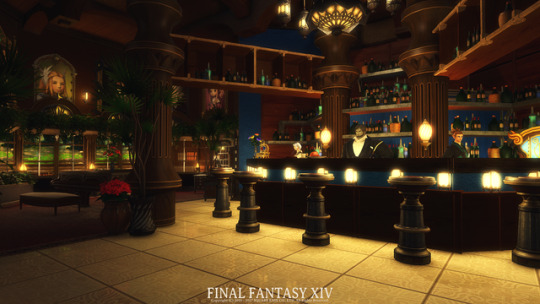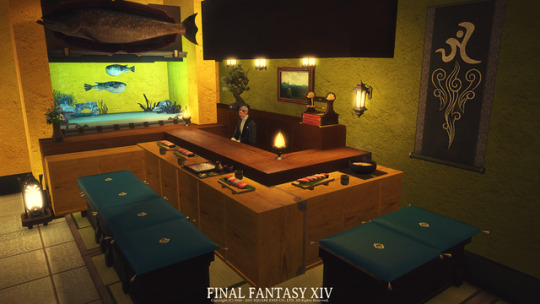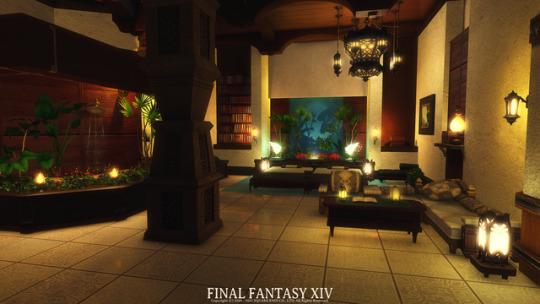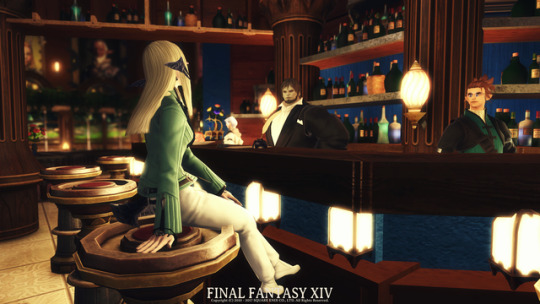A blog where I live out my love for FFXIV and occasionally share stories of my adventures
Don't wanna be here? Send us removal request.
Photo

Should you begin to lose heart, look to me in the stands, and I shall cheer so loud, you will wonder how you could ever have contrived to doubt yourself!
2K notes
·
View notes
Photo









I finally redecorated! :D Square-Enix hasn’t given us Thavnair yet, so I decided to build something like how I imagine it in my backyard! I was trying for a Near East vibe with some influences from the Far East mixed in!
If you’d like to visit, the address is Balmung Mist Ward 9, Plot 53!
(with many thanks to @tetenuko for crafting assistance, and for the advice of everyone in the FC that stopped by!)
364 notes
·
View notes
Note
Good morning, day, evening ;) I'm considering an OC with Thavnarian roots. Not much can be found about the near eastern isle though. At least not that I've succeeded in locating. Have you done a study on them before?
The Near East
Encyclopedia Eorzea: “To the south of Ilsabard lies a great sea known as the Bounty. The abundance of sea life combined with its central location in relation to the Three Great Continents has historically seen civilizations on the islands of the Bounty thrive, even during the calamitous Umbral Eras.
The most prominent of those civilizations would have to be that of Radz-at-Han, located on Thavnair-the Bounty’s largest landmass. An ancient city-state with a history stretching back thousands of years, Radz-at-Han is best known as the birthplace of modern alchemy. It is interested to note that, despite having a very limited outward military presence, the city-state has succeeded in forging a non-interference treaty with the Garlean Empire, ensuring their independence while mightier nations fall about them, and as thus, Radz-at-Han remains an active hub for trade between Eorzea. However, it has been noted by some that the treaty was only formed so that Garlemald could obtain items from Eorzea via Thavnair, as official trade between the regions was frozen after the Empire’s failed invasion twenty years prior.”
Government:
Jalzahn - Kaiser Knuckles: “When cataclysm loomed over the Near East, the hero Mirza arose to defend the people from fell fiends. Once he had torn the monsters apart, he raised a mighty empire- and fashioned a pair of weapons such as these from his foes’ claws!”
Jalzahn - Nirvana: “After long years spent spurring worldly desires, a Near Eastern hierarch rose to a higher state of being. And as he did, life itself quickened within his trusty staff, the very twin of which you now hold!”
Ahldskyf: “I would have the ship’s cook bake some bread using La Noscean flour and offer it as a gift to the ruling houses of Radz-at-Han, telling each house that the others had found its flavor to far surpass that of bread made from Ul'dahn sunset wheat. The nobles would have no choice but to agree, of course, and, not wishing to be outshone by their peers, demand that their kitchens also stock La Noscean flour.”
Known Races:
–% Near Eastern Hyur–% Near Eastern Miqo'te–% Other (High probability Roegadyn)Terminology:
“Near Eastern” = Hailing from anywhere in the Near East: southern Ilsabard, the Bounty, or Thavnair.
“Thavnairian” = Hailing specifically from the Near Eastern island of Thavnair.
“Hannish” = Hailing specifically from Thavnair’s capital, Radz-at-Han.
Industries:
Lodestone: “Masters of Science and Nature, the devilish and the divine, alchemists ensure their livelihood through the transmogrification of mundane materials into wondrous waters─from curative concoctions to potent potables. The Ul'dahn school only recently came to be recognized in scientific circles as a valid branch of alchemical orthodoxy. It is based on fundamental principles originating in the Near East tradition, but draws heavily upon esoteric elements of both Lalafellin herbalism and Miqo'te occultism as well.”
Coultenet: “The alchemists of Radz-at-Han are heirs to an ancient and storied tradition, which as seen the creation of countless medicines still in use today. The Domans have their own tradition as well, though the philosophy behind it is markedly different, from what I understand.”
Jalzahn: “Allow me to introduce myself. My name is Jalzahn, and I hail from the Near Eastern city-state of Radz-at-Han. I am an alchemist by trade. It has been my life’s work to study the enhancement of arms through soul infusion. Verily, Thavnairian mist is one of the fruits of my toils. Upon learning that the elixir had come to some prominence in Eorzea, I journeyed here with the intent of exploring new possibilities in my research. I want but for a subject to proceed.”
Yumah Molkot: “In response to recent fluctuations in the market, the [Brugaire Consortium] is sourcing these arms from the city-state of Radz-at-Han, far across the Jade Sea. I should note at this juncture that these are no ordinary weapons—they are fashioned from a peculiar stone called Giantsgall, a material traditionally used in the making of Near Eastern arms. I caught glimpse of one such blade hanging on the hip of a Twin Adder officer returning from a drill, and humbly asked if I might examine it up close. Let it suffice to say that I was duly impressed by the craftsmanship.”
The Cieldalaes to See Combat - Giantsgall: “A variety of stone found only on Thavnair, possessing exceptional hardness. Its name is derived from a legend that tells of a Far Eastern hero who voyaged to the selfsame island and there vanquished a savage giant. A nearby stone drank up the slain giant’s blood and gall, thus receiving of its strength.”
Customs and Beliefs:
Thavnairian Mistletoe: “A variety of parasitic plant that is commonly found growing on the stout acacia trees of Thavnair. The inhabitants of Thavnair’s capital city of Radz-at-Han have a strange custom that states if two people meet underneath a sprig of mistletoe, they must each give the other one of their shoes.”
Gandarewa: “It isn’t only the dragons who have brought heretics into our midst, you know. Five hundred years ago, another heretical sect gained traction among the smallfolk of Ishgard. The heathens adopted the customs of the Near East, bathing themselves in perfumes brewed from strange flowers and forging idols from rare metals that they used in their bizarre and unholy rites. Naturally, the Temple Knights were quick to clamp down on the sect’s activities. Its leader, a peasant who styled himself the great guru Gandarewa, fled to the next holiest place he knew─the sacred mountain of Dravania. There he supped on the blood of a dragon, and was forever changed…”
Food:
F’lhaminn: “Our impromptu excursion to the Near East afforded me the opportunity to sample authentic Thavnairian cuisine. I should like to introduce it to the Scions, but achieving the perfect balance of spices is key…”
Rolanberry Lassi: “A sweet and tangy drink made from cultured milk. Popular in the Near Eastern city-state of Radz-at-Han for its ability to soothe the burn of heavily spiced dishes.”
Climate:
Ahldskyf: “The nobles of Radz-at-Han are obsessive about their odor. I suppose it comes from living in a land that is subject to the incessant beating of the sun’s harsh rays. The sweltering days and muggy nights leave nearly everyone on the island drenched in a perpetual patina of malodorous wetness. To cope, they spend absurd amounts of coin on all manner of fragrances and perfumes - and as luck would have it, one of the most prized is scented with none other than Althyk lavender! You see, my friend, the plant is very rare, with most wild varieties nigh on impossible to find in even the most fertile corners of Eorzea, let alone an isolated rock in the middle of the sea!”
Mint Lassi: “A cool and refreshing drink made from cultured milk. Popular in the Near Eastern city-state of Radz-at-Han for its ability to offset the blistering heat of the Thavnairian midday sun.”
Near Eastern History and Timeline
Encyclopedia Eorzea: “After 1190, Ul'dah gained control of Thanalan, and began to trade on the high seas. Despite the ever-present threat of pirates, Ul'dah’s ships were large, and could carry far more goods than caravans. A single voyage was much more profitable than a train of men traversing the overland route. Moreover, no one charged a toll to sail over the waves. Though the change was gradual, trade with the Near East shifted to the seas.”
Year 1150: A system of tolls is enacted, to be collected from merchants travelling through Ala Mhigo and Gyr Abania in return for safe passage between Eorzea and the Near East.
Year ca.1190: After their triumph over Sil'dih, emissaries from a thriving Ul'dah board Lominsan-built ships and set sail for the Near East to establish trade.
Year ca.1200: Piracy enters its golden age, and raids by Lominsan corsairs on merchant ships laden with Ul'dahn riches are the order of the day.Ul'dahn merchants begin arming their vessels to protect their livelihoods on the open sea, but struggle to fend off the Lominsan pirates and their superior nautical aptitude.
Year 1221: The pirate king Mistbeard appears on the Five Seas, his face concealed by a ghastly mask as he unifies several pirate bands under his flagship, the Haar. His legend grows as he and his crew plunder the seas with impunity.
Year 1249: Mistbeard is reportedly slain at sea in battle with an armed merchant vessel from the Near Eastern city of Radz-at-Han.
Year 1251: A wealth of treasures is plundered from a Radz-at-Han argosy, giving rise to rumors that Mistbeard is alive and well. Time and again the pirate king is reported as dead only to resurface, leading many to believe the man immortal.
Year 1476: Great merchant caravans employing chocobo carriages are organized, and set off for the east. Meanwhile, Ala Mhigo is forced to dramatically reduce their highroad tolls as part of their terms of surrender in the Autumn War. As a result, overland transport regains popularity as an alternative to the piracy-plagued sea routes.
Year 1477: Flourishing commerce and cross-border trade prompt the need for standardization of currency and measurements. By consensus of the six city-states, the gil of ancient Allag is revived and adopted as a universal currency, and with it the ilm/onze system of weights and measures.
Dated Radz-at-Han Coin: “Currency once used on the Near Eastern island of Thavnair, now only sought by numismatists and historians.”
@the-mage-and-the-monk asked: I was wondering, do we know what currency gets used in Thavnair? I always assumed Gil is an Eorzean thing, but I could be wrong!
Gil is actually an Allagan thing, but the coins we do see in circulation today are definitely an Eorzean thing. Or so we thought until the dated Radz-at-Han coin appeared bearing the visage of Nymeia, the Spinner just like Eorzean gil.
Why? I don’t really have a concrete answer for you as to why Thavnair, a nation that to the best of our knowledge does not worship the Twelve, has the image of Nymeia on one of their ancient coins. It’s possible that, like Fernehalwes explains, at one time long ago Radz-at-Han may have worshiped the Twelve but the practice eventually diminished, or Thavnair too took inspiration from Allagan artifacts when designing their old currency.
It’s possible also that when deciding on their own universal currency, the Eorzean nations looked to Thavnairian currency for inspiration, as four of the six city-states (Ul’dah, Limsa Lominsa, Ala Mhigo, and Ishgard)traded with the Near East.
Encyclopedia Eorzea: “As contact between nations in these times was limited at best, no effort was made to introduce a universal standard, and for years, many and myriad currencies were exchanged throughout the land. This changed in the years of peace that followed the Autumn War. Trade and diplomatic relations between nations flourished, and for reasons of economic convenience, voices calling for a universal currency grew louder.
In the year 1477 of the Sixth Astral Era, the leaders of Eorzea’s six great city-states came together, and after some debate reached the decision to mint a universal currency to be used the realm over. So it came to be that gil, a coinage once used by the ancient Allagan Empire, was reinstituted as the standard currency for all the land.”
On the Design of Gil: “In times of eld, coins would typically bear designs inspired by heroes, leaders, or religious imagery of the nations that minted them. With the introduction of gil as a universal currency, however, a consensus of experts from all nations made the decision to adopt neutral designs - ones not rooted in the traditions of any one culture or nation - in the interest of avoiding needless debate. To this end, the face of Nymeia, the Spinner, was chosen to grace the one-hundred gil coin. An exception to the rule can be found in the commemorative one-gil coins issued by the grand companies for Foundation Day, which are emblazoned with the images of the leaders of their respective city-states.”
More lore on the Near East, the Zodiac Braves, Eastern Trade Routes, Thavnairian Imports, and native flora and fauna can be found in the Read More below!
The full original post on Near Eastern lore can be found here!
Weiterlesen
695 notes
·
View notes
Photo

@lavenderrpurr shared a video and I couldn’t help myself :’)
561 notes
·
View notes
Photo



Realized I haven’t been uploading here as much as I’d like to due to a lot of personal related stuff happening in my life, whoop, but have some doodles to fix that
FFXIV related again. I’d never drawn Ysayle before so I wanted to fix that, I also wanted to draw Estinien in a t-shirt since that was a running thing for a while. And then… mini-Nidhogg happened to accompany mini-Midgardsormr. he’d mainly just be around to hover near estinien and drive him mad tbh
449 notes
·
View notes
Photo



Vera’s Room, starring a very Gridanian-chic window!
359 notes
·
View notes
Text
Hingan Vocabulary
The following is a brief compendium of Hingan words used in everyday language by NPCs.
Note that only terms likely to be commonly used will be listed. Very specific terms–such as “Bushin-no-jutsu”–will not be listed.
–
ijin - “Foreigner”. Can be used both politely or rudely.
koban - Money. This is the term Hingans use instead of “gil”.
I speak only the truth. A truth that all can see─all save this two-koban rag merchant, and the amateur aesthetes who waste their coin on a clumsy child who hides her shameful lack of skill with gaudy, uncultured garb.
What are you selling? I have a few koban stashed away, if you will accept them. …What is wrong? Why do you hesitate? You are a merchant, are you not?
Thanks to you meeting with the chief, not only did I receive a generous sum of koban but I think I may have even moved up a few pegs in the Confederacy.
While the thing may have cost me a fortune, I do not regret a single koban I spent on it. This rock has proven to me that I have what it takes to protect my people and my village, and that I need nothing more than my two arms and legs to do it.
bakufu - The Hingan military government.
bugyo - Magistrate or Governor. Used in reference to the lord bugyo who rules Kugane.
sensei - “Master”. This term is extremely uncommon; it is only used once in the entire game. The generic term “Master” is used far more frequently (such as “Master Musosai”).
Kyokuho There you are! I was beginning to wonder if you hadn’t been eaten by the hoverflies on your way here! But I jest. Jannequinard tells me that you are quite the authority on all things relating the Bole. So enlighten me, oh, honorable sensei. I am, as you westerners say, all eyes…or was it ears?
kami - used as a generic substitute for “gods”. (”Kami preserve us”, etc.). In a religious sense, used to refer to the spirits that reside in precious items and treasures, as well as nature.
aibou - Generally, can be translated to “partner” or “buddy”, and can be used to refer to a close working relationship as “partner” (such as a detective and deputy). Reno and Rude from Final Fantasy 7 are an example of partners or “aibou”. In the Japanese version, Estinien calls the Warrior of Light “aibou” as well.
Hancock Who knows─we may even come to call one another “aibou”, as the Hingans do. ‘Tis a most deep and meaningful word, aibou─some translate it as “friend,” but I think it better not to even bother trying, so unique and quintessentially Hingan the concept is…
keikaku - More than likely this is nothing more than a meme reference (as localisation often is). Still. It means plan.
Jannequinard An excellent proposal…or as I believe the Hingans say, “keikaku.” I dabbled a bit in the language when I was younger but for the life of me that ebon-haired emissary would not afford me even a sidelong glan─
geiko - A skilled female entertainer. Modestly dressed, they engage in poetry, music, and dancing.
tamahagane - Can be translated as “jewel steel”. In-game terminology is “Doman steel”. Tamahagane is symbolically significant in Hingan culture, most likely as the traditional material used to make katanas.
onsen - A natural hot spring used for bathing. Thanks @samhyurai!
Feel free to add more if you find any.
691 notes
·
View notes
Photo

Let it never be said that Ishgard’s promises to the Alliance were only ever ink on parchment.
192 notes
·
View notes
Photo







Final Fantasy XIV: Heavensward Illustration Countdown - Week 1
(14: Eiichi Hama; 13: Yoshikazu Takenouchi; 12: Nobuyoshi Mihara; 11: Seiji Yamate; 10: Chieko Tomioka; 9: Rokuma Saito; 8: Sigeo Kasuya)
240 notes
·
View notes
Photo








Final Fantasy XIV: Heavensward Illustration Countdown - Week 2
(7: Ai Kishimoto; 6: Takayuki Ohdachi; 5: Kenta Tanaka; 4: Tetsu Tsukamoto; 3: Tsubasa Masao; 2: Ayumi Namae; 1: Hiroyuki Nagamine; Welcome: Kazuya Takahashi)
113 notes
·
View notes
Photo


when you’re trying to get a corrupted aether crystal to counteract geruda’s wind barrier but the first piece of shit nerd you go to for help leads you to a wind-aspected crystal and of course that won’t fucking work and then the second one sends you to a skeleton-infested island only to come back with a fire-aspected crystal only which that won’t fucking work either because you specifically need an ice-aspected crystal and you’re finally wondering just how much more of this bullshit you can take
2 notes
·
View notes























